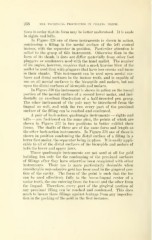Page 540 - My FlipBook
P. 540
258 THE TECHNICAL PROCEDURES IX FILLING TEETH.
tions in order tliat its form may be better understood. It is made
in rights and lefts.
In Figure 328 one of these instruments is shovra in action,
condensing a filling in the mesial surface of the left central
incisor, with the separator in position. Particular attention is
called to the grasp of this instriunent. Otherwise than in the
form of its shank, it does not differ materially from other foot
pluggers or condensers used with the hand mallet. The number
of its angles, however, requires that a much heavier blow of the
mallet be used than with pluggers that have less crooks and turns
in their shanks. This instrument can be used upon mesial sur-
faces and distal surfaces in the incisor teeth, and is capable of
use on all mesial surfaces in the bicuspids and molars, but not
upon the distal surfaces of bicuspids and molars.
In Figure 330 the instrument is shown in action on the buccal
portion of the mesial surface of a second lower molar, and inci-
dentally an excellent illustration of a half-inverted pen grasp.
The other instrument of the pair may be introduced from the
lingual as well, and with the two every part of the proximal
surface of the filling can be reached and condensed.
A pair of back-action quadrangle instruments — rights and
lefts — are fashioned on the same plan, the points of which are
shown in Figure 332 in two positions to better exhibit their
forms. The shafts of these are of the same form and length as
the other back-action instruments. In Figure 331 one of these is
shown in position condensing the distal surface of a filling in a
lower first molar, the separator being in place. It is easily appli-
cable to all of the distal surfaces of tbe bicuspids and molars of
both the lower and upper jaws.
These quadrangle instruments are not used at all for gold
building, but only for the condensing of the proximal surfaces
of fillings after they have otherwise been completed with other
instruments. Their use is more particularly desirable when
considerable non-cohesive gold has been used in the gingival por-
tion of the cavity. The form of the point is such that the toe
can be used etfectively fully to the bucco-lingual center of a
molar tooth, the one entering from the buccal and the other from
the lingual. Therefore, every part of the gingival portion of
any proximal filling can be reached and condensed. This does
much to insure these fillings against leakage from any imperfec-
tion in the packing of the gold in the first instance.


